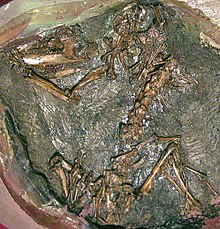Dryolestida
| Dryolestida | |
|---|---|

| |
| Skeleton of Henkelotherium | |
| Scientific classification | |
| Domain: | Eukaryota |
| Kingdom: | Animalia |
| Phylum: | Chordata |
| Class: | Mammalia |
| Clade: | Cladotheria |
| Superorder: | †Dryolestoidea Butler, 1939 |
| Order: | †Dryolestida Prothero, 1981 |
| Families and genera | |
Dryolestida is an extinct order of mammals, known from the
The group contains
Dryolestids were formerly considered part of
Morphology
Dryolestids are mostly represented by
The basal non dryolestid dryolestidan Henkelotherium from the Late Jurassic of Portugal is known from a partial articulated skeleton, and is thought to have been arboreal, adapted to climbing and living in trees.[6]
Distribution
Dryolestids are known from the Jurassic through
The oldest named member of Dryolestidae is Anthracolestes from the Middle Jurassic (Bathonian) aged Itat Formation in western Siberia.[10] Fragmentary remains attributable to dryolestidans are known from the equivalently aged Forest Marble Formation of England[11] and the Anoual Formation of Morocco.[12]
The youngests fossils of Dryolestidans in the Northern Hemisphere are the dryolestids
With the advent of the Cenozoic, dryolestoids declined drastically in diversity, with only the large dog-sized herbivore
Taxonomy
A phylogenetic analysis conducted by Rougier et al. (2012) indicated that meridiolestidans might not be members of Dryolestoidea but instead slightly more closely related to the
Cladogram after Lasseron and colleagues (2022), which found Donodontidae and Meridiolestida unrelated to Dryolestida:[2]
| Cladotheria |
| ||||||||||||||||||||||||||||||||||||||||||||||||||||||
References
- PMC 8126546.
- ^ S2CID 249324444.
- ^ a b Kielan-Jaworowska, Cifelli & Luo 2004, pp. 14, 375, 379–380
- hdl:11336/103413.
- .
- S2CID 145881918.
- ^ von Koenigswald 2000, p. 107
- PMID 33828193.
- ^ Rose 2006, pp. 335–6
- S2CID 85070390.
- ^ Freeman, E. F. 1979. A Middle Jurassic mammal bed from Oxfordshire. Palaeontology 22:135–166.
- ISSN 1342-937X.
- S2CID 247876132.
- ^ Lillegraven, J.A. and McKenna, M.C. 1986. Fossil mammals from the “Mesaverde” Formation (Late Cretaceous, Judithian) of the Bighorn and Wind River basins, Wyoming, with definitions of Late Cretaceous North American land-mammal “ages”. American Museum Novitates 2840: 1–68.
- ^ Rougier et al. 2009, p. 208.
- ^ Harper T, Parras A, Rougier GW. 2018. Reigitherium (Meridiolestida, Mesungulatoidea) an enigmatic Late Cretaceous mammal from Patagonia, Argentina: morphology, affinities, and dental evolution. Journal of Mammalian Evolution.
- ^ Florentino Ameghino (1891). "Nuevos restos de mamíferos fósiles descubiertos por Carlos Ameghino en el Eoceno inferior de la Patagonia austral. Especies nuevas, adiciones y correciones". Revista Argentina de Historia Natural. 1: 289–328.
- ^ Gelfo, J. N.; Bausza, N.; Reguero, M. (2019). "The fossil record of Antarctic land mammals: commented review and hypotheses for future research". Advances in Polar Science: 274–292. Archived from the original on 2022-01-06. Retrieved 2020-12-07.
- PMID 23169652.
- S2CID 18504005.
- ^ Nicolás R. Chimento, Federico L. Agnolin and Fernando E. Novas (2012). "The Patagonian fossil mammal Necrolestes: a Neogene survivor of Dryolestoidea" (PDF). Revista del Museo Argentino de Ciencias Naturales. Nueva Serie. 14 (2): 261–306. Archived from the original (PDF) on 2013-11-04. Retrieved 2013-03-21.
Works cited
- von Koenigswald, Wighart (2000). "Two different strategies in enamel differentiation: Marsupialia versus Eutheria". In Teaford, Mark F; Smith, Moya Meredith; Ferguson, Mark WJ (eds.). Development, Function and Evolution of Teeth. Cambridge University Press. ISBN 978-0-511-06568-2.
- Rougier, Guillermo W.; Forasiepi, Analía M.; Hill, Robert V.; Novacek, Michael (June 2009). "New Mammalian Remains from the Late Cretaceous La Colonia Formation, Patagonia, Argentina". Acta Palaeontologica Polonica. 54 (2): 195–212. S2CID 54027098.
- Rose, K.D. (2006). The Beginning of the Age of Mammals. Johns Hopkins University Press. ISBN 978-0-8018-8472-6.
Further reading
- Kielan-Jaworowska, Zofia; Cifelli, Richard L; Luo, Zhe-Xi (2004). Mammals from the Age of Dinosaurs: Origins, Evolution, and Structure. New York: Columbia University Press. pp. 14, 379–393. ISBN 978-0-231-11918-4.
- The Illustrated Encyclopedia of the Prehistoric World page 344
